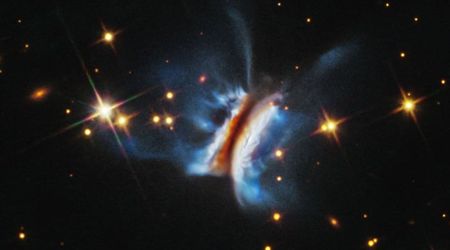SpaceX launches 23 Starlink satellites aboard brand-new Falcon 9 rocket after a last-minute abort

After a last-minute abort, SpaceX successfully 23 Starlink satellites to orbit on brand-new Falcon 9 booster on Tuesday, May 20, from Pad 40 at Cape Canaveral. The liftoff occurred at 11:19 p.m. EDT (03:19 UTC), as per Spaceflight Now.
Watch Falcon 9 launch 23 @Starlink satellites to orbit from Florida, including 13 with Direct to Cell capabilities https://t.co/TAZ3bcly5V
— SpaceX (@SpaceX) May 21, 2025
This launch used the 4th new booster brought into service by SpaceX this year, adding to their current operational fleet of 18. Before its successful launch, the new booster was temporarily brought into horizontal positions on Tuesday. This enabled engineers to resolve a problem that had halted the countdown at T-2 minutes and 28 seconds during Monday's first attempt. After the initial scrub, SpaceX had only stated that an "auto abort" occurred, reassuring that "Vehicle and payload are in good health, and teams are resetting for a launch attempt no earlier than Tuesday, May 20." By late Tuesday afternoon, the rocket was back upright at Space Launch Complex 40.
Falcon 9 had an auto abort just prior to T-0. Vehicle and payload are in good health, and teams are resetting for a launch attempt no earlier than Tuesday, May 20
— SpaceX (@SpaceX) May 20, 2025
The mission proceeded with precision, as B1095 landed safely on the droneship 'Just Read the Instructions' just over eight minutes after liftoff. This recovery was the 121st for the vessel and SpaceX's 449th booster landing overall. Inside the payload fairing were 23 satellites, 13 of which are equipped for direct-to-cellphone communications. SpaceX confirmed their deployment roughly an hour and five minutes into the flight, after a second stage burn established their final circular orbit.

One of SpaceX's previous launches on Friday, May 16, at 6:43 a.m. PT, saw a Falcon 9 rocket carry 26 Starlink satellites into low-Earth orbit. The liftoff occurred from Space Launch Complex 4 East (SLC-4E) at Vandenberg Space Force Base in California.
Falcon 9 deploys 26 @Starlink satellites, completing our 125th mission from pad 4E in California pic.twitter.com/aUOU57erDG
— SpaceX (@SpaceX) May 16, 2025
Designed and manufactured by SpaceX, Falcon 9 is a reusable, two-stage rocket engineered for the reliable and safe transport of both people and payloads to Earth orbit and beyond. As the world's first orbital-class reusable rocket, Falcon 9 enables SpaceX to refly its most costly components, significantly reducing the expense of accessing space. As of May 21, 2025, Falcon 9 has completed 475 missions, achieved 430 total landings, and conducted 400 total reflights, according to SpaceX's official website.

The Falcon 9 rocket is a marvel of engineering, beginning with its first stage. This stage is powered by nine Merlin engines, fueled by liquid oxygen and rocket-grade kerosene stored in aluminum-lithium alloy tanks, generating over 1.7 million pounds of thrust at sea level. Connecting two stages is the composite interstage, which also houses pneumatic pushers for separation during flight. Four hypersonic grid fins, located at the base of the interstage, are crucial for orienting the rocket during reentry by adjusting its center of pressure.
The second stage, propelled by a single Merlin Vacuum engine, is responsible for delivering the payload to its precise orbit. This engine can ignite multiple times, allowing for the deployment of various payloads into different orbital paths. Finally, the fairing, made of carbon composite, protects satellites during ascent. It separates approximately three minutes into flight and is recovered by SpaceX for reuse, further enhancing the rocket's cost effectiveness, as mentioned on SpaceX.









